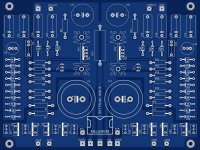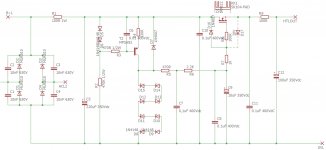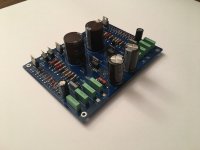Under
A New High-Voltage Regulator
is mentioned an easy to realize high voltage regulator - go to the third schematic.
For the TIP 150 I want to use a version with an isolated outline like TO220F (MJF13009) or SOT186A (BUT18F)
Unfortunately the Hfe of MJF13009 or BUT18F is too low.
Maybe there are a direct replacement for the TIP150 in the wanted outline.
Thank you for an advice.
A New High-Voltage Regulator
is mentioned an easy to realize high voltage regulator - go to the third schematic.
For the TIP 150 I want to use a version with an isolated outline like TO220F (MJF13009) or SOT186A (BUT18F)
Unfortunately the Hfe of MJF13009 or BUT18F is too low.
Maybe there are a direct replacement for the TIP150 in the wanted outline.
Thank you for an advice.
Have you looked at the --TIP160 ?
This is a TO3P die (plastic ) .
I notice your in Germany I have the excellent German equivalents books-
ECA.de they come in alphabetical numbering and numerical numbering, quite a few BJT,s to choose from.
German engineering efficiency.
This is a TO3P die (plastic ) .
I notice your in Germany I have the excellent German equivalents books-
ECA.de they come in alphabetical numbering and numerical numbering, quite a few BJT,s to choose from.
German engineering efficiency.
Those circuits work just fine with a mosfet. Add a clamp to the gate-source. You can get 600+ volt isolated package TO-220’s any day of the week at Mouser. The types they sell are going to change every couple months so you’ll never get the same thing twice, but something similar is always available.
You can also darlington an MJF13007/9 with a KSC2752, if you have to have bipolars and want more than 20 Hfe. The 2752 is a 400 volt iso TO-126, good if you’re looking for ‘safer’ MJE340 replacements for current sources, etc.
You can also darlington an MJF13007/9 with a KSC2752, if you have to have bipolars and want more than 20 Hfe. The 2752 is a 400 volt iso TO-126, good if you’re looking for ‘safer’ MJE340 replacements for current sources, etc.
Under
A New High-Voltage Regulator
is mentioned an easy to realize high voltage regulator - go to the third schematic.
For the TIP 150 I want to use a version with an isolated outline like TO220F (MJF13009) or SOT186A (BUT18F)
Unfortunately the Hfe of MJF13009 or BUT18F is too low.
Maybe there are a direct replacement for the TIP150 in the wanted outline.
Thank you for an advice.
If you want one adjustable, protected, with a ready PCB, how about this one:
T-reg HV regulator | Linear Audio NL
Jan
Certainly not a bad circuit, as it comes from J.B., but it offers few advantages: it is a buffered reference, enhanced with voltage multiplication, ie. not requiring a high voltage zener, but other than that, the advantages are meager: poorer PSRR and line regulation, 2 additional HV transistors of the P variety.
The choice of a BJT as a pass transistor is also problematic: the SOAR of such devices is extremely limited, as for all of the switching devices (BUTxyz, etc).
A few Japanese devices have a wider HV SOA, but the way to go is to use a NMOS of the old generation (newer FETs have comparable SOA issues).
On DIYaudio, you can find many proven designs of regulators based on MOSFETS, using broadly the same number of parts and offering substantially higher performances
The FDP12N60 I use in T-reg has enough SOA to endure indefinite short at 400mA at 600V input. Of course, it will eventually get too hot so there is a circuit that shuts it down after a fraction of a second. But that means that short-term 400mA pulses will be OK.
Jan
Jan
TO220FP is a dead end with regards to dissipation, 40W seems to be the ceiling for that package. and most devices cannot dissipate more then 15W on a 2K/W heatsink. Taking derating for high voltage DC duty in account i cannot see a situation where short overloads wont destroy the regulator.
I'd stick to parallel TIP50 if i where you. Or find a regulator that will accept one of the excellent L2 series of linear mosfets, The latter are devices specifically made for DC regulator duty. As a matter of fact, TIP50 was the only cheap NPN HV device i could find that had a 100mA/400V SOA at TME.
There is also the option of taking a LM317HV (LM317AHVT?) and putting it in the cathode lead of some trioded EL36/PL36's to create a "tube maida" if you want i have a board design lying around somewhere for just that in EAGLE. there is a thread on the topic named " Simplest possible tube regulator -- will it work?"
I'd stick to parallel TIP50 if i where you. Or find a regulator that will accept one of the excellent L2 series of linear mosfets, The latter are devices specifically made for DC regulator duty. As a matter of fact, TIP50 was the only cheap NPN HV device i could find that had a 100mA/400V SOA at TME.
There is also the option of taking a LM317HV (LM317AHVT?) and putting it in the cathode lead of some trioded EL36/PL36's to create a "tube maida" if you want i have a board design lying around somewhere for just that in EAGLE. there is a thread on the topic named " Simplest possible tube regulator -- will it work?"
Last edited:
I agree v4lve those small power BJT give good specs but in practical reality they blow due to overheating as do the same mosfet versions , I replaced them long ago with TO3P die mosfets which are still working in all my amps after more than 30 years.
I still have the original Hitachi TO3 mosfets I replaced with TO3P versions they seem to last forever even when testing a new circuit and HF oscillations cause them to over heat and blacken
I still have the original Hitachi TO3 mosfets I replaced with TO3P versions they seem to last forever even when testing a new circuit and HF oscillations cause them to over heat and blacken
I have good experience with L2 devices, those are expensive compared to their non Linear specified counterparts, but their SOA means that well cooled they will survive short circuits some indefinitely if you have a NPN to turn the supply into a ccs at short circuit wheras a BJT at those voltages turns into an expensive fuse.
Ive tried Broskies circuit lower on the page with a LH0002 buffer for driving the FET and a LM358 and it works just fine without frequency compensation. alternatively you can use a LM7323 so you can cut out the negative supply requirement and the gate driver. Get a LM385-1.2 and a high value resistor and build your own high voltage LM317 😉
Ive tried Broskies circuit lower on the page with a LH0002 buffer for driving the FET and a LM358 and it works just fine without frequency compensation. alternatively you can use a LM7323 so you can cut out the negative supply requirement and the gate driver. Get a LM385-1.2 and a high value resistor and build your own high voltage LM317 😉
why not just use the LR8 high voltage regulator, up to 415V and tag a TIP50 at the output...simple! All you need are a handful of parts!
Also this.
Is a dual mono board.
Very efficent .
You can ask them ( I have a collaboration)
Audioelettronica componenti elettronici Hi End
audioceleste@gmail.com
Walter
Is a dual mono board.
Very efficent .
You can ask them ( I have a collaboration)
Audioelettronica componenti elettronici Hi End
audioceleste@gmail.com
Walter
Attachments
I use LR8 with mosfets - works very well.. Conceptually very similar to Waltube's design with the LR8 replacing the CCS and zener stack.
Waltube, that is the best circuit yet low noise as well.
It could be if you delete R9 ...
If you leave it in, you partly undo everything you did with that clean source follower.
Jan
Last edited:
The R1 and R9 are just to limit the in rush current on power on but can be omitted.
In every case the ripple is very very low. With or without (U2 song)
About LR8 it is very interesting and now I am playing with it for a variable HT with a good success ( with a power fet )
At 300 Vdc with 60-80 mA the ripple residual is 5-10 mV rms
Walter
Walter
In every case the ripple is very very low. With or without (U2 song)
About LR8 it is very interesting and now I am playing with it for a variable HT with a good success ( with a power fet )
At 300 Vdc with 60-80 mA the ripple residual is 5-10 mV rms
Walter
Walter
I use LR8 with mosfets
"I use LR8 with mosfets"
Kevin,
would you have, and share, a drawing/schematic of a neat layout for your LR8/mosfet reg?
thanks
tim
"I use LR8 with mosfets"
Kevin,
would you have, and share, a drawing/schematic of a neat layout for your LR8/mosfet reg?
thanks
tim
Hi Tim,
Yes I'd be delighted to share, but regard this as a guide, it's certainly not the last word. I do recommend if you think there is any likelihood of an output short that you add a 15V zener from gate to source. The resistor string in the feedback circuit satisfies the LR8 minimum load requirement to properly regulate while not putting much of a load on it .This is what I use in my phono stages and it has proven quite reliable over about 25 samples (group buys) over the past 3 years or so. You can safely change the gate resistors to 220 ohms if you are concerned about the noise contribution of the gate stopper resistor.
Yes I'd be delighted to share, but regard this as a guide, it's certainly not the last word. I do recommend if you think there is any likelihood of an output short that you add a 15V zener from gate to source. The resistor string in the feedback circuit satisfies the LR8 minimum load requirement to properly regulate while not putting much of a load on it .This is what I use in my phono stages and it has proven quite reliable over about 25 samples (group buys) over the past 3 years or so. You can safely change the gate resistors to 220 ohms if you are concerned about the noise contribution of the gate stopper resistor.
Attachments
our own Salas has a 300 volt version of the Salas regulator, a series CCS and shut regulator combo....please check it out...
Thanks Kevin,
Perhaps I shouldn't have used the word schematic as I really meant a component & wiring layout diagram.
Neat and compact layout is what I always find most difficult.
stay safe
tim
Perhaps I shouldn't have used the word schematic as I really meant a component & wiring layout diagram.
Neat and compact layout is what I always find most difficult.
stay safe
tim
- Home
- Amplifiers
- Tubes / Valves
- 300V High-Voltage Regulator for Tube Pre - Transistor wanted in TO220F resp. TO220ISO



